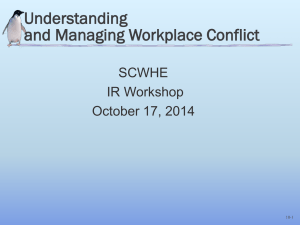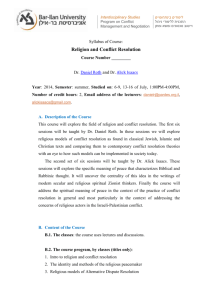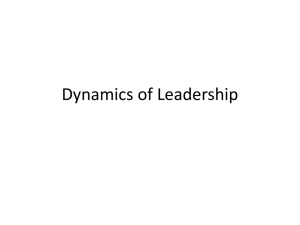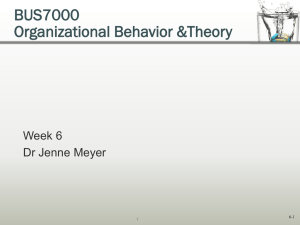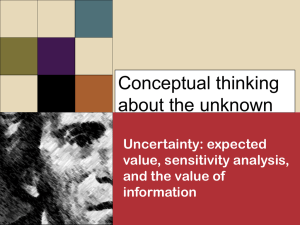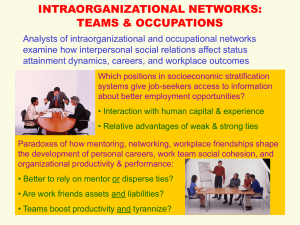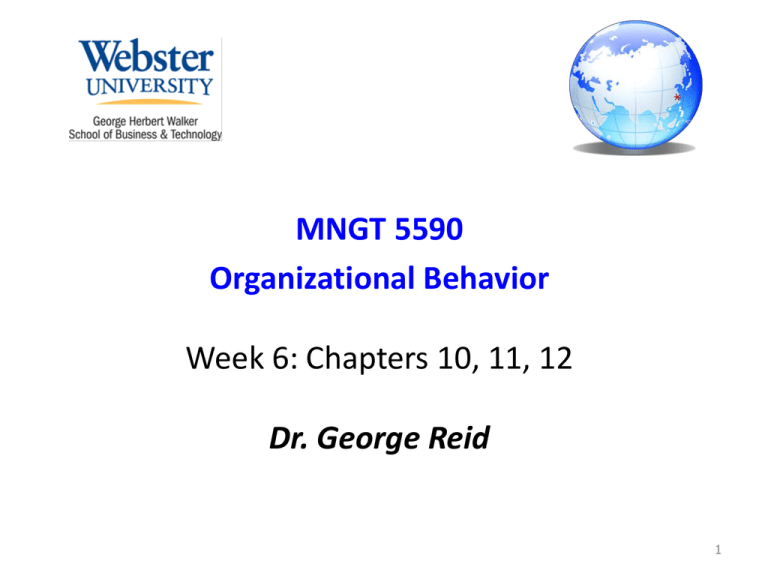
MNGT 5590
Organizational Behavior
Week 6: Chapters 10, 11, 12
Dr. George Reid
1
• Chapter 10: Power and
Influence
• Chapter 11: Conflict and
Negotiation
• Chapter 12: Leadership
2-2
10
Power and Influence
in the Workplace
Copyright © 2015 McGraw-Hill Education. All rights reserved. No reproduction or distribution without the prior written consent of McGraw-Hill Education.
Whale Power at JP Morgan
Through unconstrained power and influence, a
handful of traders (including the infamous London
Whale) in the London bureau of JP Morgan’s chief
investment office produced a mammoth $7 billion
loss.
10-4
The Meaning of Power
The capacity of a person, team, or
organization to influence others
Potential to change attitudes and behavior
(not actual change)
People may be unaware of their power
Perception –target perceives powerholder
controls a valuable resource
Power involves unequal dependence
10-5
Power and Dependence
Person B’s
countervailing
power over
Person A
Person A
Person A is
perceived as
controlling resources
that help or hinder
Person B’s goal
achievement.
Person B’s
Goal
Person B
Person A’s
power over
Person B
10-6
Model of Power in Organizations
Sources
of Power
Legitimate
Reward
Coercive
Expert
Referent
Power
over others
Contingencies
of Power
10-7
Legitimate Power
Agreement that people in certain roles can
request certain behaviors of others
Zone of indifference -- range of behaviors for
deference to authority
Norm of reciprocity -- felt obligation to help
someone who has helped you
Information control -- right to distribute
information to others
Creates dependence
Frames situation
10-8
Expert Power
Capacity to influence others by possessing
knowledge or skills that they value
Coping with uncertainty
Organizations operate better in predictable
environments
People gain power by using their expertise to:
Prevent environmental changes
Forecast environmental changes
Absorb environmental changes
10-9
Other Sources of Power
Reward power
Control rewards valued by others, remove
negative sanctions
Coercive power
Ability to apply punishment
Referent power
Capacity to influence others through identification
with and respect for the power holder
Associated with charisma
10-10
Contingencies of Power
Sources
of Power
Power
over others
Contingencies
of Power
Substitutability
Centrality
Discretion
Visibility
10-11
Increasing Nonsubstitutability
Substitutability – availability of alternatives
More power when few/no alternatives
Reduce substitutability through:
Monopoly over resource
Controlling access to the resource
Differentiating the resource
10-12
Other Contingencies of Power
Centrality
Degree and nature of interdependence with powerholder
Higher centrality when (a) many people affected and (b)
quickly affected
Visibility
You are known as holder of valued resource
Increases with face time, display of power symbols
Discretion
The freedom to exercise judgment
Rules limit discretion
Discretion is perceived by others
10-13
Power Through Social Networks
Social networks – people connected to
each other through forms of
interdependence
Generate power through social capital -goodwill and resulting resources shared
among members in a social network
Three power resources through networks
Information
Visibility
Referent power
10-14
Social Network Ties
Strong ties:
Close-knit relationships (frequent
interaction, high sharing, multiple roles)
Offer resources more quickly/plentifully,
but less unique
Weak ties
Acquaintances
Offer unique resources not held by us or
people in other networks
Many ties
Resources increase with number of ties
Limited capacity to form weak/strong ties
10-15
Social Network Centrality
Person’s importance in a network
Three factors in centrality:
Betweenness – extent you are located
between others in the network
Degree centrality -- Number of people
connected to you
Closeness – stronger relationships
A
B
Example: “A” has highest centrality
due to all three factors; “B” has
lowest centrality
10-16
Influencing Others
Influence is any behavior that attempts to alter
someone’s attitudes or behavior
Applies one or more power bases
Essential activity in organizations
Coordinate with others
Part of leadership definition
Everyone engages in influence
10-17
Types of Influence
Silent
Authority
• Following requests without overt influence
• Based on legitimate power, role modeling
• Common in high power distance cultures
Assertiveness • Actively applying legitimate and coercive
power (“vocal authority”)
• Reminding, confronting, checking,
threatening
more
10-18
Types of Influence (con’t)
Information
Control
• Manipulating others’ access to information
• Withholding, filtering, re-arranging
information
Coalition
Formation
• Group forms to gain more power than
individuals alone
1. Pools resources/power
2. Legitimizes the issue
3. Power through social identity
more
10-19
Types of Influence (con’t)
Upward
Appeal
• Appealing to higher authority
• Includes appealing to firm’s goals
• Alliance or perceived alliance with higher
status person
Persuasion
• Logic, facts, emotional appeals
• Depends on persuader, message content,
message medium, audience
more
10-20
Types of Influence (con’t)
Impression
Management
• Actively shaping or public image
• Self-presentation
• Ingratiation
Exchange
• Promising or reminding of past benefits in
exchange for compliance
• Negotiation, reciprocity, networking
10-21
Organizational Politics
Manipulating/influencing others:
Negative: For personal gain or approval (narrow selfinterest)
Positive: For the benefit of others or the future
(enlightened self-interest)
10-22
10
Power and Influence
in the Workplace
10-23
11
Conflict and
Negotiation in the
Workplace
Copyright © 2015 McGraw-Hill Education. All rights reserved. No reproduction or distribution without the prior written consent of McGraw-Hill Education.
Is Conflict Good or Bad?
Negative Outcomes
Positive Outcomes
• Wastes time, energy, resources • Fuller debate of decision
choices
• Less information sharing,
productivity
• More organizational politics
• More job dissatisfaction,
turnover, stress
• Weakens team cohesion
(when conflict is within team)
• Decision assumptions are
questioned
• Potentially generates more
creative ideas
• Improves responsiveness to
external environment
• Increases team cohesion
(conflict with other teams)
11-25
Emerging View: Task Versus
Relationship Conflict
Task (constructive) conflict
Parties focus on the issue, respect people with
other points of view
Try to understand logic/assumptions of each
position
Relationship conflict
Focus on personal characteristics (not issues) as the
source of conflict
Try to undermine each other’s worth/competence
Accompanied by strong negative emotions
11-26
Minimizing Relationship Conflict
Goal: encourage task conflict, minimize
relationship conflict
Problem: relationship conflict often develops
when engaging in task conflict
Three conditions that minimize relationship
conflict during task conflict:
Emotional intelligence
Cohesive team
Supportive team norms
11-27
The Conflict Process
Sources of
Conflict
Conflict
Perceptions
and
Emotions
Manifest
Conflict
Conflict
Outcomes
Conflict
Escalation Cycle
11-28
Structural Sources of Conflict
Incompatible
Goals
• One party’s goals perceived to interfere
with other’s goals
Differentiation
• Different values/beliefs
• Explains cross-cultural, generational,
merger conflict
Interdependence
• Conflict increases with interdependence
• Parties more likely to interfere with each
other
11-29
Structural Sources of Conflict
Scarce
Resources
• Motivates competition for the resource
Ambiguous
Rules
• Creates uncertainty, threatens goals
• Encourages political behavior
Communication
Problems
• Rely on stereotypes
• Less motivation to communicate
• Arrogant language escalates conflict
11-30
Five Conflict Handling Styles
Forcing
Assertiveness
High
Problem-solving
Compromising
Avoiding
Low
Yielding
Cooperativeness
High
11-31
Conflict Handling Contingencies
Problem solving
Best when:
Interests are not perfectly opposing
Parties have trust/openness
Issues are complex
Problem: other party may use information to its
advantage
Forcing
Best when:
you have a deep conviction about your position
quick resolution required
other party would take advantage of cooperation
Problems: relationship conflict, long-term relations
11-32
Conflict Handling Contingencies
Avoiding
Best when:
conflict is emotionally-charged (relationship conflict)
conflict resolution cost is higher than benefits
Problems: doesn’t resolve conflict; causes frustration
Yielding
Best when:
other party has much more power
issue is much less important to you than other party
value/logic of your position is imperfect
Problems: increases other’s expectations; imperfect
solution
11-33
Conflict Handling Contingencies
Compromising
Best when:
Parties have equal power
Quick solution is required
Parties lack trust/openness
Problem: Sub-optimal solution where mutual gains
are possible
11-34
11
Conflict and
Negotiation in the
Workplace
11-35
Leadership Defined
Leadership is the ability to influence, motivate, and
enable others to contribute toward the
effectiveness of the organizations of which they are
members
12-36
Shared Leadership
The view that leadership is a role, not a
position assigned to one person
Employees lead each other – e.g., champion ideas
Shared leadership flourishes where:
Formal leaders are willing to delegate power
Collaborative (not competitive) culture
Employees develop effective influence skills
Distributed leadership…
12-37
Transformational Leadership Model
Build
commitment
to the vision
Develop/com
municate a
strategic vision
Elements of
Transformational
Leadership
Encourage
experimentation
Model the
vision
12-38
Managerial Leadership
Definition: Daily activities that support and guide the
performance and well-being of individual
employees and the work unit to support current
objectives and practices
Managerial leadership differs from transformational
leadership
Assumes environment is stable (vs dynamic)
Micro-focused (vs macro-focused)
Transformational and managerial leadership are
interdependent
12-39
Task vs People Styles of
Leadership
Task-oriented behaviors
Assign work, clarify responsibilities
Set goals and deadlines, provide feedback
Establish work procedures, plan future work
People-oriented behaviors
Concern for employee needs
Make workplace pleasant
Recognize employee contributions
Listen to employees
Both styles necessary, but different effects
12-40
Servant Leadership
Leaders serve followers toward their need fulfillment,
development, growth
Described as selfless, egalitarian, humble, nurturing,
empathetic, and ethical coaches
Servant leader
characteristics:
1. Natural calling to
serve others
2. Humble, egalitarian,
accepting relationship
3. Ethical decisions and actions
12-41
Other Managerial Leadership
Theories
Situational Leadership Model
Four styles: telling, selling, participating, delegating
Best style depends on follower ability/motivation
Popular model, but lacks research support
12-42
Authentic Leadership
Know Yourself
Be Yourself
• Engage in selfreflection
• Develop your own
style
• Feedback from
trusted sources
• Apply your values
• Know your life story
• Maintain a positive
core self-evaluation
12-43
Gender Issues in Leadership
Male/female leaders have similar task- and peopleoriented leadership
Female leaders use more participative leadership
Women rated higher on emerging leadership styles
12-44
12
Leadership in
Organizational
Settings
12-45

